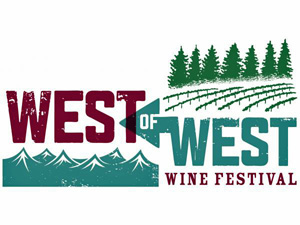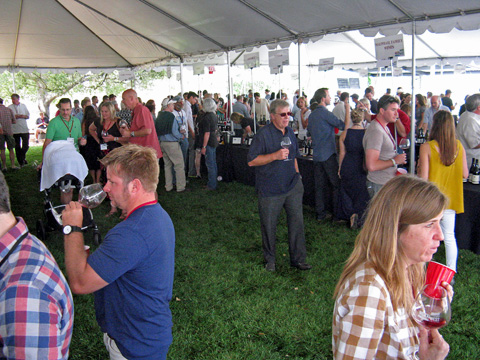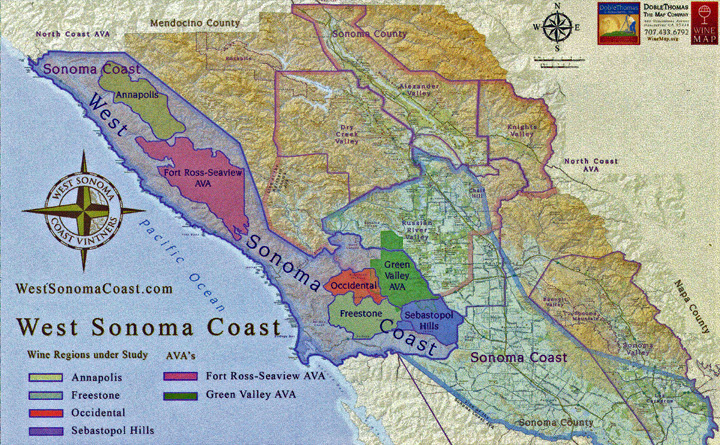Alma Fria
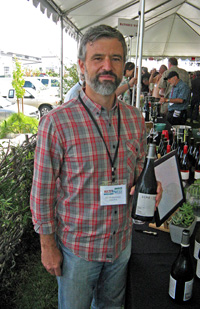 |
Alma Fria 2012 Chardonnay, Sonoma Coast. Sourced from Hawk Hill and Weeks vineyards in the Freestone area, full malolactic fermentation with no new oak. Light color, featuring pear and lemonpeel along with some spice and floral aromas. Medium-bodied with good acidity and lively finish, nice.
Alma Fria 2012 Pinot Noir, Sonoma Coast. Sourced from four vineyards (including the estate vineyard), about 15% whole-cluster fermentation, aged in 10% new oak. Medium-light ruby color, with black cherry, tea leaf, and spices. Medium weight on the palate with milder tannins.
Alma Fria 2012 Pinot Noir, Holtermann Vineyard, Sonoma Coast. From Pommard, 115, 777, and 828 clones, aged in 20% new oak. Medium-light color, this was more earthy, along with black cherry and tea leaf notes plus a floral element. Medium-bodied with bright acidity, finishing with fine tannins.
Alma Fria 2012 Pinot Noir, Doña Margarita Vineyard, Sonoma Coast. From Pommard and 115 clones, aged in 25% new oak. Medium-light color, this showed brighter black cherry and plum fruit, spice, forest floor, and a touch of sweet oak in the background. Medium-bodied with a slightly richer texture and more structure than the previous wine, and firm tannins on the finish – already nice but this will benefit from time in the cellar.
Comments: Alma Fria is a new project started by the Holtermann family, whose background is in wine importing. In 2012 they purchased a small vineyard just north of Annapolis that’s planted to Chardonnay and Pinot Noir. They also source fruit from Marimar Estate’s Doña Margarita Vineyard between Freestone and Occidental, and from other vineyards as well. Red Car’s Carroll Kemp makes the wines. Proprietor Jan Holtermann poured his wines, which were quite good.
Baker Lane Vineyards
Baker Lane 2013 Rosé, Sonoma Coast. From Syrah farmed for Rosé with three picks between 19-22 brix, whole-cluster pressed and fermented in neutral puncheons. Light salmon/pink, with floral aromas plus strawberry and fresh herbs. Lighter-bodied with juicy acidity and a touch of tannin on the fresh finish, nice.
Baker Lane 2012 Pinot Noir, “Sonoma Coast Cuvée,” Sonoma Coast. Aged in 40% new puncheons. Lighter ruby color, this was herbal and earthy with strawberry and spice undertones. Medium-light weight with bright acidity and milder tannins.
Baker Lane 2010 Pinot Noir, “Reserve,” Sonoma Coast. Sourced from Ramondo Vineyard and aged in 45% new puncheons. Medium-light color, showing darker fruit, a smoky oak component, and baking spice. Medium-bodied with a richer texture than the previous wine, finishing with moderate tannins.
Baker Lane 2009 Syrah, Estate, Sonoma Coast. Co-fermented with about 3% estate Viognier and aged in puncheons, about 20% new. Medium-dark purple, with savory/herbal aromas along with blackberry fruit, earth, olives, and a slight floral note. Medium-full bodied with a lively mouthfeel and firm tannins on the finish, tasty but deserving of further time in the cellar.
Comments: Fruit for the Baker Lane wines comes mostly from their estate vineyard near Sebastopol and from nearby Ramondo Vineyard, which they lease and farm. The first Baker Lane wines came from the 2004 vintage, and the label focuses on Pinot Noir, Syrah, Rosé, and a new estate Viognier. Owner/winemaker Stephen Singer and vineyard manager Greg Adams were behind the table pouring the wines.
Ceritas Wines
Ceritas 2012 Chardonnay, Charles Heintz Vineyard, Sonoma Coast. From organically-farmed 35+ year old vines in Goldridge soil near Occidental, made in older oak. Very light straw color, this showed bright lemon along with some lees and spice on the nose. Medium-light bodied, with vibrant acidity and a long, clean finish.
Ceritas 2012 Chardonnay, Porter-Bass Vineyard, Sonoma Coast. From biodynamically-farmed 30+ year old vines, made in older oak. Light straw color, this had pear and orangepeel aromas plus fresh herbs. Medium weight on the palate with crisp acidity and a long, flavorful finish, nice.
Ceritas 2012 Pinot Noir, Hellenthal Vineyard, Sonoma Coast. From own-rooted Calera selection vines in a separate block planted in 1980 by David Hirsch in the remote Fort Ross-Seaview area, fermented with 50% whole clusters. Medium-light ruby color, featuring tea leaf, spice, and earth, with strawberry fruit and a stony mineral note. Medium-bodied and well-structured, this had a long finish with moderate tannins, nice – tempting already but this should age very well.
Ceritas 2012 Pinot Noir, Escarpa Vineyard, Sonoma Coast. From a north-facing site near Occidental that was replanted in 2013, 75% whole-cluster fermentation. Medium-light color, with a darker fruit profile than the previous wine, as well as more apparent stem/herb character. Bigger on the palate with plenty of structure for aging, this showed a stony element on the finish along with grippier tannins.
Comments: John Raytek and his wife Phoebe Bass founded Ceritas in 2005, and the focus has been mainly on Sonoma Coast Chardonnay and Pinot Noir. Phoebe’s family owns Porter-Bass Vineyard, located near Forestville. John was on hand to pour their wines at the tasting. I thought that Ceritas poured the strongest group of wines that I tasted at the event.
Claypool Cellars
CC Pachyderm 2012 Pinot Noir, Sonoma Coast. Sourced from three vineyards, aged in about 25% new oak. Medium-light color, this displayed raspberry and black cherry fruit, tea leaf, a floral note, and sweet oak in the background. Medium-bodied with a lively mouthfeel and bright finish with fine tannins, nice.
CC Pachyderm 2012 Pinot Noir, Rice-Spivak Vineyard, Sonoma Coast. Aged in 30% new oak. Slightly darker color, this showed bigger oak and spice components along with red fruits, flowers, and earth. A bit bigger on the palate with moderate tannins and a stony mineral note on the finish.
Comments: Claypool Cellars was launched in 2007 by famed Primus vocalist/bassist Les Claypool, who’s lived in western Sonoma County for 20 years. The focus has been on Russian River and Sonoma Coast Pinot Noir. In late 2011, Ross Cobb (of Cobb and Hirsch) and Katy Wilson (of LaRue) were brought in to head up the Claypool winemaking team.
Cobb Wines
Cobb 2008 Pinot Noir, Jack Hill Vineyard, Sonoma Coast. Aged in 35% new French oak. Medium-light garnet color, featuring tea leaf and earth, red fruits, plus spice and pepper notes. Medium-bodied with a lively mouthfeel and finish.
Cobb 2009 Pinot Noir, Joy Road Vineyard, Sonoma Coast. Aged in 35% new French oak. Medium-light color, with a higher-toned and darker fruit profile, along with lots of spice. Bright mouthfeel with a long finish.
Cobb 2011 Pinot Noir, Coastlands Vineyard, Sonoma Coast. Aged in 30% new French oak. Slightly lighter color, this was less fruit-forward, with savory herbal notes, strawberry, and touches of flowers and forest floor. Medium-light weight on the palate, finishing with fine tannins, nice.
Comments: Ross Cobb (who also makes the wines for Hirsch Vineyards) was behind the table at the tasting. Jack Hill, Joy Road, and Coastlands (Cobb’s estate vineyard) are all located in the Occidental area. Ross’ parents David and Diane first planted Coastlands Vineyard in 1989, and David and Ross established the Cobb label in 2001.
Failla Wines
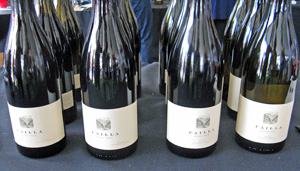 |
Failla 2012 Chardonnay, Sonoma Coast. Sourced mostly from the estate vineyard, made in stainless steel, concrete, and French oak. Very light color, this displayed apple and pear fruit, some spice and lees notes, and hints of flowers and fresh herbs. Medium-light weight with vibrant acidity and a chalky texture on the long finish, nice.
Failla 2012 Pinot Noir, Sonoma Coast. Made from younger vines sourced from a number of vineyards, with about 30% Hirsch fruit, aged in 20% new oak. Medium-light color, with black cherry, spice, and dried herbs. Medium-light bodied with moderate tannins and a long finish.
Failla 2012 Pinot Noir, Hirsch Vineyard, Sonoma Coast. From Blocks 3 and 8 at Hirsch Vineyard, with Pommard and Mount Eden clones. Medium-light ruby color, this was less fruit-forward than the previous wine, with earth, forest floor, and spice upfront and red fruits in support. Bigger and more structured, with good acidity and a tingly finish with fine tannins.
Failla 2012 Pinot Noir, Occidental Ridge Vineyard, Sonoma Coast. Medium-light color, showing a more floral character along with red fruits, spice, and orangepeel notes. Medium-bodied with a bright texture and moderate tannins on the long finish, nice.
Comments: Originally called Failla Jordan, the winery was founded in 1998 by winemaker Ehren Jordan and his wife Anne-Marie Failla. Their first Pinot was a Keefer Ranch bottling from the 1999 vintage, and Pinot has been at the core of the wine production over the years. Failla has an estate vineyard located in the Fort Ross-Seaview AVA.
Freeman Vineyard & Winery
Freeman 2012 Pinot Noir Rosé, Sonoma Coast. Made by the saignée method. Light salmon color, featuring bright strawberry and spice aromas. Medium-bodied with a fairly smooth texture and finish.
Freeman 2012 Pinot Noir, Sonoma Coast. Sourced from eight vineyards (including noted sites such as Campbell Ranch, Hellenthal, and Thorn Ridge) and aged in 36% new oak. Medium-light ruby color, with tea leaf, earth, and strawberry on the nose, with a background of spice and sweet oak. Lively acidity on the palate with fine tannins and a long finish, nice.
Freeman 2012 Pinot Noir, “Akiko’s Cuvée,” Sonoma Coast. A barrel selection, sourced from six vineyards in 2012 (Campbell Ranch near Annapolis makes up the largest percentage) and aged in 33% new oak. Medium-light color, this showed more spice and vanilla/oak than the previous wine, along with red fruits and a slight floral note. Bigger and more structured, with more grip on the finish – this will need time in the cellar to develop.
Comments: Established in 2001 by Ken and Akiko Freeman, the winery features a striking wine cave tunneled into the hills west of Sebastopol. Making exclusively Chardonnay and Pinot Noir, Akiko heads up the winemaking team, which includes consulting winemaker Ed Kurtzman. Freeman farms a 7-acre estate vineyard near the winery and a newer 14-acre vineyard located just three miles from the ocean.
Furthermore Pinot Noir
Furthermore 2013 Rosé, California. Sourced from a variety of wine regions. Light pink color, with ripe strawberry fruit and a touch of fresh herbs. Medium-bodied with a smooth but lively texture and finish.
Furthermore 2010 Pinot Noir, Bohemian Vineyard, Sonoma Coast. From 115, 667, and 777 clones from a site in the Freestone area. Medium ruby color, displaying ripe and slightly higher-toned black cherry and plum fruit, spice, and undertones of vanilla/oak. Medium-bodied, this had a tangy finish.
Furthermore 2012 Pinot Noir, Nevina’s Vineyard, Sonoma Coast. From Furthermore’s new estate vineyard near Occidental, with 667 clone and recently-added 777. Medium-light color, this had black cherry, earth, tea leaf and stony mineral notes on the nose. Medium weight on the palate with good acidity, finishing with fine tannins, nice.
Furthermore 2012 Pinot Noir, Gloria Vineyard, Sonoma Coast. Sourced from the Freeman estate vineyard west of Sebastopol. Medium-light color, somewhat higher-toned red fruit, spice, and herb aromas. Richer texture than the previous Pinots, with a fairly smooth finish.
Comments: Launched in 2006 by Bob Zeches and Chad Richard, Furthermore produces their wines in San Francisco. The winery makes exclusively Pinot Noir, sourced from a number of vineyards in Sonoma, Mendocino, Monterey, and Santa Barbara Counties. Nevina’s is Furthermore’s new estate vineyard in the Occidental area, planted in 2001 and acquired by the winery in 2011. (Disclosure – I helped bottle the Furthermore 2012 Pinots and 2013 Rosé)
Gros Ventre Cellars
Gros Ventre 2012 Pinot Noir, Sonoma Coast. Sourced from several vineyards, including Campbell Ranch and Baranoff. Medium-light color, with ripe black cherry, spice, and undertones of vanilla/oak. Medium-bodied with good acidity and fine tannins.
Gros Ventre 2012 Pinot Noir, Campbell Ranch, Sonoma Coast. From a vineyard in the Annapolis area. Medium-light ruby color, this showed a more savory/herbal character with more upfront earth and tea leaf aromas along with black cherry and raspberry fruit. Bigger and more structured on the palate, finishing with more pronounced tannins, nice.
Gros Ventre 2012 Pinot Noir, “First Born,” Sonoma Coast. Not yet released, this is a barrel selection that changes each vintage, the 2012 is largely from a vineyard in the Fort-Ross Seaview AVA. Slightly darker color, with a bigger spice component along with plummy fruit, dried herbs, and sweet oak. Medium weight and structured for aging, with lively acidity and big but refined tannins.
Comments: Gros Ventre was launched in 2009 by Chris and Sarah Pittenger – Chris was on hand to pour his wines at the event. Chris is also the winemaker for Skinner Vineyards in El Dorado County, where the wines are made. Gros Ventre specializes in Pinot Noir from the Sonoma Coast, Russian River Valley, and Anderson Valley. LaRue Wines
LaRue 2012 Pinot Noir, Sonoma Coast. Sourced from about 40% Rice-Spivak and 60% Emmaline Ann vineyards, aged in 35% new French oak. Lighter ruby color, bright red fruits, tea leaf, spice, and stony mineral aromas. Medium-light bodied with a lively mouthfeel and long finish, nice.
LaRue 2012 Pinot Noir, Emmaline Ann Vineyard, Sonoma Coast. Aged in 50% new French oak, just 12.4% alcohol. Slightly darker color, this featured bright cherry fruit, earth, dried herbs, and a wet stone note, plus a touch of sweet oak in the background. Medium-light bodied and a bit richer in texture and more structured than the previous wine, finishing with firmer tannins – a promising young Pinot that will need cellar time to show its best.
Comments: LaRue makes exclusively Sonoma Coast Pinot Noir. Owner/winemaker Katy Wilson launched the LaRue label with a Sonoma Coast Pinot from the 2009 vintage. She’s worked at a variety of noted wineries, including Craggy Range in New Zealand, Testarossa, and Flowers. Rice-Spivak Vineyard is located in the Sebastopol Hills, while Emmaline Ann is in the Occidental area. As usual Katy was on hand to pour her wines at the event.
|
Lioco Wine Company
Lioco 2012 Chardonnay, Hanzell Vineyard, Sonoma Valley. Whole-cluster pressed and made in neutral oak. Light color, with apple skin, citrus, and spice on the nose. Moderately rich mouthfeel with a long, smooth finish.
Lioco 2012 Pinot Noir, “Laguna,” Sonoma Coast. Sourced from several vineyards including Hirsch and Teac-Mor, fermented with about 30% whole clusters and aged in 15% new oak. Medium-light color, featuring bright red fruits, earth, and lots of spice. Medium-bodied with milder tannins and a tangy finish.
Lioco 2012 Pinot Noir, Hirsch Vineyard, Sonoma Coast. From Mount Eden, Pommard, and 114 clones, about 40% whole-cluster fermentation, aged in 20% new oak. Medium-light color, this had more savory and herbal aromas, plus earth and flowers, with black cherry and spice in support. Bigger and more structured than the “Laguna” bottling, with a lively texture and fine tannins on the finish, nice.
Comments: Established in 2005 by wine importer Matt Licklider and sommelier Kevin O'Connor, Lioco combines their last names. Their focus is Chardonnay, Pinot Noir, and Carignan from Sonoma, Mendocino, and Santa Cruz counties. John Raytek of Ceritas took over as the Lioco winemaker in 2011.
Littorai Wines
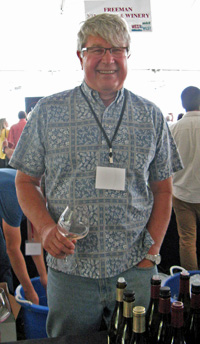 |
Littorai 2012 Chardonnay, Charles Heintz Vineyard, Sonoma Coast. From the noted vineyard near Occidental, planted in the early 1980s. Very light straw color, with citrus, spice, a slight floral note, and a background of vanilla/oak. Medium-light bodied with juicy acidity and a long, crisp finish, nice.
Littorai 2012 Pinot Noir, The Pivot Vineyard, Sonoma Coast. From Littorai’s biodynamically-farmed estate vineyard adjacent to their winery southwest of Sebastopol. Medium-light ruby color, this featured earthy and herbal elements upfront, with black cherry, tea leaf, and spice in support. Medium-bodied with a lively mouthfeel and fine tannins on the tangy finish, nice.
Littorai 2012 Pinot Noir, The Haven Vineyard, Sonoma Coast. From a site northwest of Occidental, planted in 2001. Medium-light color, showing more vanilla/oak on the nose, along with black cherry and plum fruit and spice. Richer on the palate but retaining good acidity, with moderate tannins and a tingly finish.
Littorai 2012 Pinot Noir, Mays Canyon Vineyard, Sonoma Coast. Also known as Porter-Bass Vineyard, this is located near Guerneville. Medium-light color, with darker berry aromas along with earth, herbs, and a touch of sweet oak. Bigger and more structured, with tannins that could use some bottle age to mellow.
Comments: Littorai Wines was established by Ted and Heidi Lemon in 1993. The Lemons purchased property in 2003 between Sebastopol and Freestone and completed a gravity-flow winery built with straw-bale construction there in 2008. All of the Littorai vineyards are farmed organically or biodynamically – the estate Pivot Vineyard at the winery property is part of an overall biodynamic farm there. Craig Provin, whom I’ve known for many years, was behind the table pouring the Littorai wines.
Peay Vineyards
Peay 2012 Chardonnay, Estate, Sonoma Coast. Made in about 30-35% new French oak. Very light straw color, with apple, lemonpeel, spice, and undertones of vanilla/oak on the nose. Lighter-bodied, with fresh acidity and a clean finish, nice.
Peay 2012 Pinot Noir, Sonoma Coast. Sourced from the estate vineyard and nearby Campbell Ranch. Medium-light ruby color, this showed pretty floral aromas along with red cherry and lots of spice. Medium-light weight, this finished with fairly mild tannins.
Peay 2012 Pinot Noir, “Ama,” Estate, Sonoma Coast. Slightly darker color, and also displaying a darker fruit profile than the previous wine, with black cherry, flowers, spice, and a stony mineral note. Bigger structure than the previous wine, with good acidity and moderate tannins, nice.
Peay 2012 Pinot Noir, “Scallop Shelf,” Estate, Sonoma Coast. Medium color, this had more savory, meaty aromas along with black cherry and plum fruit, tea leaf, and sweet oak. Lively on the palate with plenty of structure and more grip on the finish – this has potential but clearly needs more time in the cellar.
Peay 2012 Syrah, “Les Titans,” Estate, Sonoma Coast. Medium-dark purple, with dark berry fruit, smoked meat, dried herbs, and a touch of vanilla/oak. Big and structured in the mouth, with grippy tannins on the finish – it’s tasty even now but this deserves more bottle age to develop to its fullest.
Comments: Peay Vineyard is located near the town of Annapolis. The Peay label is run by the husband-and-wife team of Nick Peay, who farms the vineyard, and Vanessa Wong, who makes the wine, and by Nick’s brother Andy, who handles the marketing and sales work. The 51-acre organically-farmed estate vineyard was first planted in 1998, and includes Chardonnay, Pinot Noir, Syrah, Viognier, Marsanne, and Roussanne. Nick was behind the table for the West of West tasting.
Ramey Wine Cellars
Ramey 2012 Chardonnay, Sonoma Coast. About 70% of the blend for 2012 is from Martinelli’s Charles Ranch Vineyard in the Fort Ross-Seaview AVA, aged for 12 months in 16% new oak. Light straw color, featuring bright citrus fruit, fresh herbs, and flowers. Medium weight on the palate with a lively texture and a long finish, nice.
Ramey 2011 Chardonnay, Platt Vineyard, Sonoma Coast. Aged on the lees for 20 months in 50% new oak. Light straw color, with aromas of apple skin, earth, and spice, plus a background of vanilla/oak. Richer mouthfeel than the previous wine but retaining good acidity, this showed lots of spice on the long finish.
Comments: David Ramey and his wife Carla founded the winery in 1996, and David and Cameron Frey head up the winemaking team there. Platt Vineyard is located above the town of Bodega, with Wente clone Chardonnay vines planted on Goldridge soil. The wines are fermented with native yeasts, and are stirred weekly. Both wines were very good and quite different from one another.
Senses Wines
 |
Senses 2012 Chardonnay, Sonoma Coast. Sourced from two vineyards, fermented in 100% new oak puncheons and aged in 90% neutral oak, with extended lees contact. Very light straw color, this displayed aromas of higher-toned apple and pear fruit plus herbs and lees. Medium-bodied with good acidity and a smooth finish.
Senses 2012 Pinot Noir, Sonoma Coast. Sourced from Hillcrest Vineyard (115, 828, Swan, and Calera clones) and Tanuda Ridge Vineyard (115 and Swan clones). Medium-light ruby color, with savory/herbal aromas upfront along with black cherry, earth, and a touch of baking spice. Medium-bodied with a lively texture and a chalky mineral note on the finish, nice.
Senses 2012 Pinot Noir, Hillcrest Vineyard, Sonoma Coast. A non-commercial wine from a single neutral barrel of Swan clone Pinot. Medium-light garnet color, with black cherry fruit and lots of spice on the nose. Medium weight on the palate, this finished with moderate tannins.
Comments: Senses is a new project from three longtime friends Chris Strieter, Max Thieriot, and Myles Lawrence-Briggs. The parents of Max and Myles are owners of noted Occidental-area vineyards – B.A. Thieriot Vineyard and Hillcrest Estate Vineyard respectively. Nearby Tanuda Ridge Vineyard is also a fruit source. Noted vintner Thomas Rivers Brown makes the Senses wines. Myles, Max, and Max’s wife Lexi were behind the table at the event, and poured a sample of a non-commercial wine they’d made in addition to their inaugural Senses releases.
Siduri Wines
Siduri 2012 Pinot Noir, Hirsch Vineyard, Fort Ross-Seaview. From Pommard, Mount Eden, and 667 clones, with a small percentage of whole-cluster fermentation. Medium-light ruby color, with earth and herb aromas plus red fruits and spice. Medium-bodied with good acidity and a moderate tannins, this has the potential to develop very nicely.
Siduri 2012 Pinot Noir, Sonatera Vineyard, Sonoma Coast. From Pommard, 115, and 777 clones, with a small percentage of whole-cluster fermentation. Medium-light color, showing riper black cherry fruit, tea leaf, and lots of spice on the nose. Medium weight on the palate with a bit bigger structure than the Hirsch bottling and more noticeable tannins on the finish.
Comments: Established in 1994 by Adam and Dianna Lee, Siduri was a pioneer in the urban “warehouse winery” movement with their Santa Rosa facility. The Lees’ Novy label, launched in 1999, includes wines from many grape varieties, but Siduri has remained exclusively Pinot Noir from the start. Although they source Pinot fruit from various California (and Oregon) wine regions, Siduri has produced Sonoma Coast Pinots for nearly 20 years, starting with their first Hirsch Vineyard bottling in 1995. Adam was behind the table at the tasting.
Small Vines Wines
Small Vines 2012 Chardonnay, Sonoma Coast. Sourced entirely from Wente clone at Barlow Homestead in the Sebastopol area, planted by Small Vines in 2009 and organically-farmed, and made in 10% new French oak, 10% stainless steel, and 80% older oak. Light straw color, with apple and pear fruit plus some floral and leesy notes. Medium-bodied with a fairly smooth mouthfeel and finish.
Small Vines 2012 Pinot Noir, Sonoma Coast. From 943, 459, Pommard, and Swan clones at Barlow Homestead Vineyard, aged in 25% new French oak. Medium-light color, featuring shy aromas of red fruits along with earth and dried herbs. Medium-light weight in the mouth, finishing with fine tannins.
Small Vines 2012 Pinot Noir, MK Vineyard, Sonoma Coast. From 114, 115, 667, 777 clones from a vineyard planted by Small Vines in 1999 near Occidental and organically-farmed, 25% whole-cluster fermentation and aged in 45% new French oak. Medium-light ruby color, this showed a more savory/herbal character along with black cherry fruit, spice, and a touch of vanilla/oak. Medium-bodied with more structure than the previous wine, and a stony mineral element on the finish, nice.
Comments: Paul and Kathryn Sloan established their Small Vines Viticulture business in 1998, developing and farming high-density planted vineyards in the Russian River Valley and Sonoma Coast. They released the first Small Vines Wines Pinot from the 2005 vintage, and Byron Kosuge has been the consulting winemaker since 2010. 2011 marked the first harvest of the Small Vines estate Barlow Homestead Vineyard near Sebastopol.
Wayfarer Vineyard
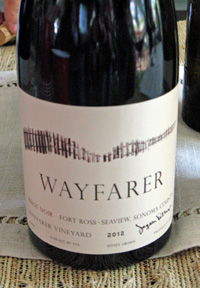 |
Wayfarer 2012 Chardonnay, Estate, Wayfarer Vineyard, Fort Ross-Seaview. Fermented and aged in 65% new French oak. Light yellow-gold color, with apple and pear fruit, baking spice, and a big vanilla/oak component. Rich mouthfeel and a smooth finish.
Wayfarer 2012 Pinot Noir, Estate, Wayfarer Vineyard, Fort Ross-Seaview. From 12 Pinot clones, native fermentation with 8% whole clusters, aged in 78% new French oak. Medium-light ruby color, this displayed ripe black cherry, earth, and spice on the nose along with a framework of sweet oak. Medium-bodied with lively acidity and fine tannins on the finish.
Wayfarer 2012 Pinot Noir, “Golden Mean,” Estate, Wayfarer Vineyard, Fort Ross-Seaview. From Pommard and Swan clones, native fermentation with 10% whole clusters, aged in 80% new French oak. Medium-light color, with more of a red fruit profile, lots of spice, and notes of forest floor and vanilla/oak. Richer texture than the previous wine but retaining good acidity, and moderate tannins on the tangy finish.
Comments: Although the Pahlmeyer label has been best-known for its Napa Valley red wine, they’ve made Sonoma Coast Chardonnay and Pinot for a number of years. In 1999, Jayson Pahlmeyer purchased the Wayfarer site, located in the Fort Ross-Seaview area. It was planted in 2001 and its fruit has been part of the winery’s Sonoma Coast blends since 2005. Jayson’s daughter Cleo is taking charge of the new Wayfarer label along with noted winemaker Bibiana Gonzalez Rave. The first release of the Wayfarer wines will be in fall 2014.
Zepaltas Wines
Zepaltas 2012 Chardonnay, Charles Heintz Vineyard, Sonoma Coast. First Charles Heintz Chardonnay from Zepaltas, this had about 12 hours of skin contact prior to pressing, aged in 33% new French oak. Light yellow-straw color, featuring citrus, spice, and vanilla/oak aromas. Medium-light bodied with a lively texture and finish.
Zepaltas 2012 Pinot Noir, Sonoma Coast. Sourced from four vineyards, including Suacci and DeVoto, aged in 33% new French oak. Medium-light color, this was earthy and herbal, along with black cherry fruit and lots of spice. Medium weight on the palate with moderate tannins.
Zepaltas 2012 Pinot Noir, Suacci Vineyard, Sonoma Coast. From a vineyard west of Occidental, all 115 clone. Medium-light garnet color, with savory/herbal aromas plus bright red fruit, earth, smoke, and a touch of pepper. Medium-bodied with a vibrant texture and lingering finish, nice.
Zepaltas 2012 Pinot Noir, DeVoto Vineyard, Sonoma Coast. From a vineyard in the on Gold Ridge Road west of Sebastopol, entirely from 828 clone. Medium-light color, this was more fruit-forward, with black cherry, spice, and stem/herb notes. Bigger and more structured, finishing with firm tannins.
Comments: Ryan Zepaltas (who’s also the assistant winemaker at Siduri) started his own label in 2004, focusing mostly on Chardonnay and Pinot Noir from the Sonoma Coast and Russian River Valley. He typically uses about 40-50% whole-cluster fermentation on his Pinots. As usual, Ryan was behind the table at the tasting.
|


